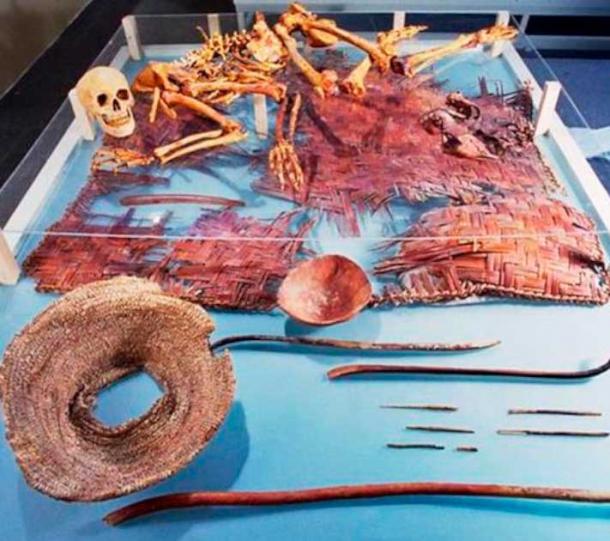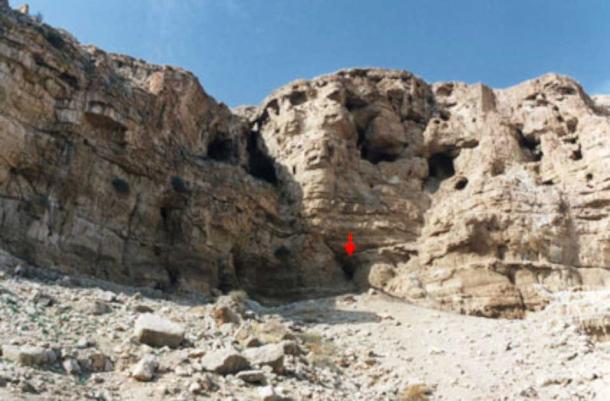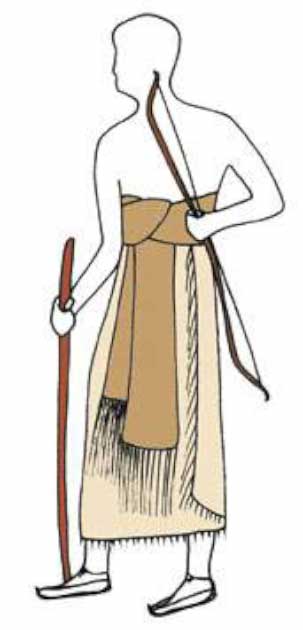
Fascinating Details of Judean Shepherd’s Life 6,000 Years Ago Revealed by New Tech
New technology has allowed scientists to discover fascinating details about the life of a Judean shepherd that lived and died around 6,000 years ago.
In the 21st century the deductive power of archaeology has grown by leaps and bounds. Largely because of various technological advances and breakthroughs, archaeologists are now able to extract far more detail from artifacts, ruins, and buried skeletons than they were able to in the past.
A fresh example of this is an analysis published late last year in the Journal of Eastern Mediterranean Archaeology and Heritage Studies. Working under the sponsorship of the Israel Antiquities Authority, a team of archaeologists reexamined the remains of an individual male skeleton taken from a cave in the Judean Desert near Jericho nearly three decades ago. As a part of this study, they also scrutinized and reanalyzed the various artifacts found buried near or alongside this person, to gain further insights into this individual’s life and living circumstances. Through this intensive analysis they were able to create a “micro-history” of what we now know was a Judean shepherd, despite the fact that he lived and died in the Late Chalcolithic period (4500-3900 BC).

The Chalcolithic shepherd’s belongings, pictured here in a museum exhibit, were analyzed by 21st-century technology to create a highly-detailed microhistory of someone who lived in the Judean Desert nearly 6,000 years ago. (The Israel Museum, Jerusalem)
Microhistory Forensics Reveals A Judean Shepherd
The type of narrowly focused examination performed here is a relatively recent innovation in archaeology. Using the most up-to-date scientific technologies and tools, archaeologists and ancient historians can learn so many details about an individual’s life that they automatically increase their understanding of that person’s culture and society. The profile created during this type of analysis is referred to as a one-person microhistory. Microhistories like the one created for the Chalcolithic shepherd are changing the way archaeology uses “personal” data to tell us more about these societies in general.
- Dead Sea Scroll Fragments Discovered In Judean Desert Cave
- Fascinating Asphalt-Coated Skulls Excavated in Israel Date to 7,000 BC
“One-person microhistory focuses on an individual and traces their life,” Israel Antiquities Authority Geoinformatics Manager Dr. Hai Ashkenazi explained, in a recent article he wrote for Haaretz about this research project (Dr. Hai Ashkenazi was the project leader). “Micro-historians try to understand that personal life story and use it to extrapolate about the lifestyle of a larger society.”

The skeleton of the Chalcolithic shepherd and his belongings were found in this Wadi el-Makkukh area cave in the Judean Desert about 30 years ago. (The Israel Museum, Jerusalem)
Not All Ancients Were Warriors!
In 1993, archaeologists entered a small cave in the Wadi el-Makkukh region of the Judean Desert. As they explored the cave further they eventually unearthed the remains of a single skeleton wrapped in fabric and partially hidden beneath a straw mat. Placed next to the skeleton were an assortment of tools and utensils, including a bow and two arrows, a short blade made from flint, a longer blade made from the same type or rock, a wooden bowl, a coiled-straw basket, a 41-inch (105-centimeter) wooden stick, and footwear that resembled a pair of sandals.
All of these items were extremely well-preserved in the arid desert cave. Because of their state, the archaeologists hypothesized that the person buried there must have lived and died during the period of the Bar Kochba Revolt (132-136), a Jewish rebellion against Roman Empire rule in the province of Judea.
This was a reasonable conclusion, since the many artifacts unearthed in Judean Desert caves typically date to either the time of the Bar Kochba Revolt or to the much earlier Late Chalcolithic period. Based on this dating and the nature of some of the artifacts found beside him, the archaeologists deduced that the man was likely a warrior who had fought during the fierce second-century conflict that pitted Roman occupiers against Judea’s homegrown population. The small cave was referred to as the Cave of the Warrior from that point on.
While these conclusions seemed reasonable at the time, it is now known that they were mistaken. New radiocarbon dating tests of organic traces found in the excavation layer revealed that the individual had been buried in the Cave of the Warrior in approximately 3760 BC. This pushed the date of his life and death back nearly 4,000 years to the Late Chalcolithic, completely negating the idea that he’d been a soldier who battled the Romans.
During this still Neolithic era, the people who lived in the region were pastoralists who grazed sheep and goats and cultivated crops like grains, lentils, and fruits grown in orchards.
To understand the ancient man’s role in his society, the archaeologists involved in the new analysis took a much closer look at his personal belongings. What they found showed that the man had not been a warrior at all, as previously thought, but was instead a Judean shepherd given the task of tending herds for his people.

Reconstruction of the nobleman, now shepherd, from roughly 6,000 years ago in full garb. (The Israel Museum, Jerusalem)
Walking in a Shepherd’s Shoes through Archaeology
The ancient sandals represented a remarkable find. Footwear from this long ago is seldom recovered, and the only reason these cowhide sandals survived is because of the protected cave environment and the arid desert soil conditions that resist decay.
These sandals were an unusual discovery, but they were especially important for another reason. Tests showed that a substance stuck on their bottom contained microscopic particles of a type only produced in the stomach of herbivores and released in through feces. This means the man had stepped in dung left by domesticated animals, which is something that would have happened quite often to someone engaged in shepherding work.
The wooden bowl was another item that helped the archaeologists identify the man as a Chalcolithic shepherd. In size and shape the bowl closely resembled bowls found at a site in Israel’s Negev Desert, which is known to have been used as a campsite by shepherds in more recent times. A bowl of this kind would have been ideal for grinding, crushing, and mixing food, and the signs of wear on this artifact suggest it was used daily. It was likely carried from place to place by an individual who was often on the move and would have needed his own personal bowl to carry with him.
Pollen grains found embedded in the man’s various personal items showed that he must have lived in a community in a hilly region just west of the cave, where grazing activities would have been practiced in ancient times. The fabrics he was wrapped in would have been suitable for making a sash and skirt, which was typical wardrobe for a shepherd. The bow and arrow he carried would have allowed him to hunt birds and small animals to supplement his regular diet when he was away from his community. The straw basket would have held his some of his belongings, and he could have slept on the straw mat at night under the stars.
An extensive examination of the man’s skeletal remains revealed more fascinating details about his life and health.
He was approximately 63 inches (160 centimeters) tall, and he would have likely been in his 40s at the time he died. This would have been considered old during the times when he lived, since the average lifespan at that time was about 30. The man’s teeth were in terrible condition, consistent with some level of malnutrition. However, his bones were thick and strong, indicating he’d been physically active and had well-developed muscles (as would be expected of a shepherd).
The man had suffered a broken leg not long before he died, but it seems this had fully healed and therefore was not directly related to the cause of his death. However, signs of wear in the heels of one of his sandals, plus the presence of the long wooden stick, suggested he’d walked with a limp in his latter days and needed to use a cane for support. Perhaps his weakened condition had compromised his chances of survival in some unknown way and had ultimately played some role in his demise.

Microhistory and modern forensic technologies are making it possible to “recreate” very detailed individual ancient lives that also tell us more about the societies they lived in. This is a dreamy desert scene showing a modern shepherd in ancient landscape in the Sudan. (YiannisMantas / Adobe Stock)
21st-century Archaeology Is Revealing New Secrets
Taken in total, everything revealed during this intensive investigation is consistent with the conclusion that the man who lived during the Late Chalcolithic period and was buried in the “Cave of the Warrior” was a Judean shepherd. All his personal items would all have been useful and practical for someone who lived the shepherd’s lifestyle, and he lived in a community that would have relied on grazing animals as a vital source for food and other resources.
In addition to what a microhistory investigation can disclose about the life of one person, this type of investigation is ideal for the study of ancient cultures and societies.
- Judean Elites Sipped Vanilla Wine 2,600 Years Ago
- The Judean Date Palm: Extinct Tree Resurrected from Ancient Seeds
“The rare state of preservation of the findings in the Cave of the Warrior presented a singular opportunity to describe the microhistory of a lone individual,” Dr. Ashkenazi wrote in his Haaretz article. “Instead of engaging with long-term processes or the history of dynasties and monarchs, here was an opportunity to understand the life of an ordinary person who lived 6,000 years ago.”
Modern analytical tools and techniques have enabled this type of detailed reconstruction of an individual life and society. Archaeology is advancing and historical understanding is advancing right along with it, at a pace that would have shocked archaeologists even 30 or 40 years ago.
Top image: Thanks to 21st-century technology we are now able to examine ancient artifacts, like those found with a Judean shepherd, to learn fascinating details about his life. Source: sajis / Adobe Stock
By Nathan Falde
















Comments
Absolutely fascinating. What a great read. Thank you for this.
We tend to focus on the big events in history, but it’s the lives of those who were living at the time that can reveal some of the most detailed and valuable information.